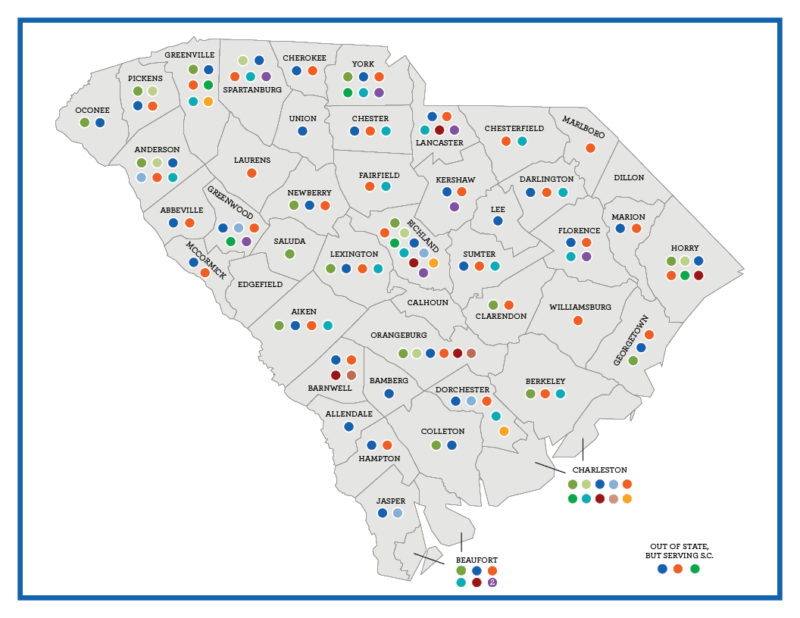Why Arts Matter

For more than 50 years, South Carolina has made a public investment in the arts through the South Carolina Arts Commission.
Among other things, the results so far include:
- $114 million in grants going back into our communities since 1967;
- 30-plus years of the Arts in Basic Curriculum (ABC) Institute in our state, a partnership that provides leadership to achieve quality, comprehensive arts education for all students each year;
- targeted grants and programs that help artists become entrepreneurs and fuel a $9.7 billion impact on the state’s economy;
- access to arts commission grants, programs, and services in all 46 counties,
- and a large and growing network of local arts providers statewide.
Our staff serves South Carolina in: arts learning, artist development, and community arts development. We help arts providers offer unique arts experiences to residents and visitors. From free poetry readings and gallery crawls to sweetgrass basketry workshops and ticketed dance, music, or theatre performances, they create an environment that contributes to quality of life from three “corner” counties of Oconee, Horry, and Beaufort to the 43 arranged inside.
FY23 impact
In FY23, the S.C. Arts Commission
- distributed 623 grants totaling $11 million, which includes:
- The SCAC made 619 annual grants totaling just less than $11 million to in-state artists, organizations, schools, or school districts.
- Four grants totaling $95,025 went to partners based out of state that helped the SCAC accomplish its work in South Carolina.
See what programs are at work in which communities on our FY23 Impact Map.
SCAC grantmaking exceeds $11 million again in FY23
We seek to improve the education of every child in this state in and through the arts.
As a founding partner in the Arts in Basic Curriculum (ABC) Institute, the S.C Arts Commission provides 440 schools professional development and grants to support standards-based arts education for all students. While “arts ed” is the gateway to lifelong participation in the arts, it also promotes success for students who might not respond to traditional academic approaches. Research reveals additional benefits: increased student engagement, workforce readiness, and 21st-century skills. These benefits are especially pronounced among students at the low end of the socioeconomic spectrum – an unfortunately large part of our population.

A summer STEAM camp by SCAC partner Engaging Creative Minds.
Arts education also grows creativity and is one of the only places in the school curriculum where you actively develop and practice it. Business and industrial leaders realize creativity must be the source and substance of good jobs for our state, countering jobs claimed by automation and overseas outsourcing. Through the S.C. Chamber of Commerce, they joined the S.C. Association of School Administrators and S.C. Council on Competitiveness to develop, propose, and convince the state board of education to adopt the Profile of the South Carolina Graduate in 2015, and the state legislature codified its principles in 2016.
From the start, the arts were a critical component of this rigorous system of standards that boasts unanimous support among educators, business leaders, and elected officials. The goal is to foster creativity, innovation, and critical thinking in our students by using an arts-enriched educational framework that provides world-class knowledge and life and career skills.
In February 2019, the S.C. Arts Commission and Palmetto State Arts Education released ground-breaking findings from participation in the 2018 Gallup Student Poll. Students in arts-rich South Carolina schools:
- reported higher hope and engagement than the national mean,
- beat the national and state mean scores even if their school had 75% or more participation in the Free or Reduced Price Lunch program,
- and had better results the longer their school offered arts-rich an curriculum.
Though the Gallup Student Poll has surveyed 6 million children over 10 years, this was the first time it was used to look specifically at arts-rich schools.
- Read more about the 2018 Gallup Student Poll in arts-rich South Carolina schools
- See the latest numbers from our partner Palmetto State Arts Education
Helping creatives contribute economically is the nexus of arts education and artist development. It makes South Carolina competitive.
After all, a well-developed cadre of creatives need work here or they’ll move elsewhere. The $14 billion South Carolina arts and creative sector increases our state’s creative capital, and enhances competitiveness. The S.C. Arts Commission offers a host of artist development programs intended to help #SCartists grow as artists and, if they choose, as entrepreneurs.
Where community development is concerned, the arts catalyze change.
We’re seeing renewal fostered by our The Art of Community: Rural SC program. What began in six rural, Lowcountry counties has spread to rural communities in 15 counties. Art of Community empowers new voices to take on old problems with creative approaches as they build new relationships, create pride of place, and inspire community building using arts and culture. This program is a national model for creative placemaking and was featured in a briefing in January 2018 at the National Press Club in Washington.

One final example of the arts’ public value is their broad, bipartisan support.
The arts, through the S.C. Arts Commission, maintain significant support from both parties in both chambers of the General Assembly, with legislators recognizing the benefits of the state’s half-century of investment.

